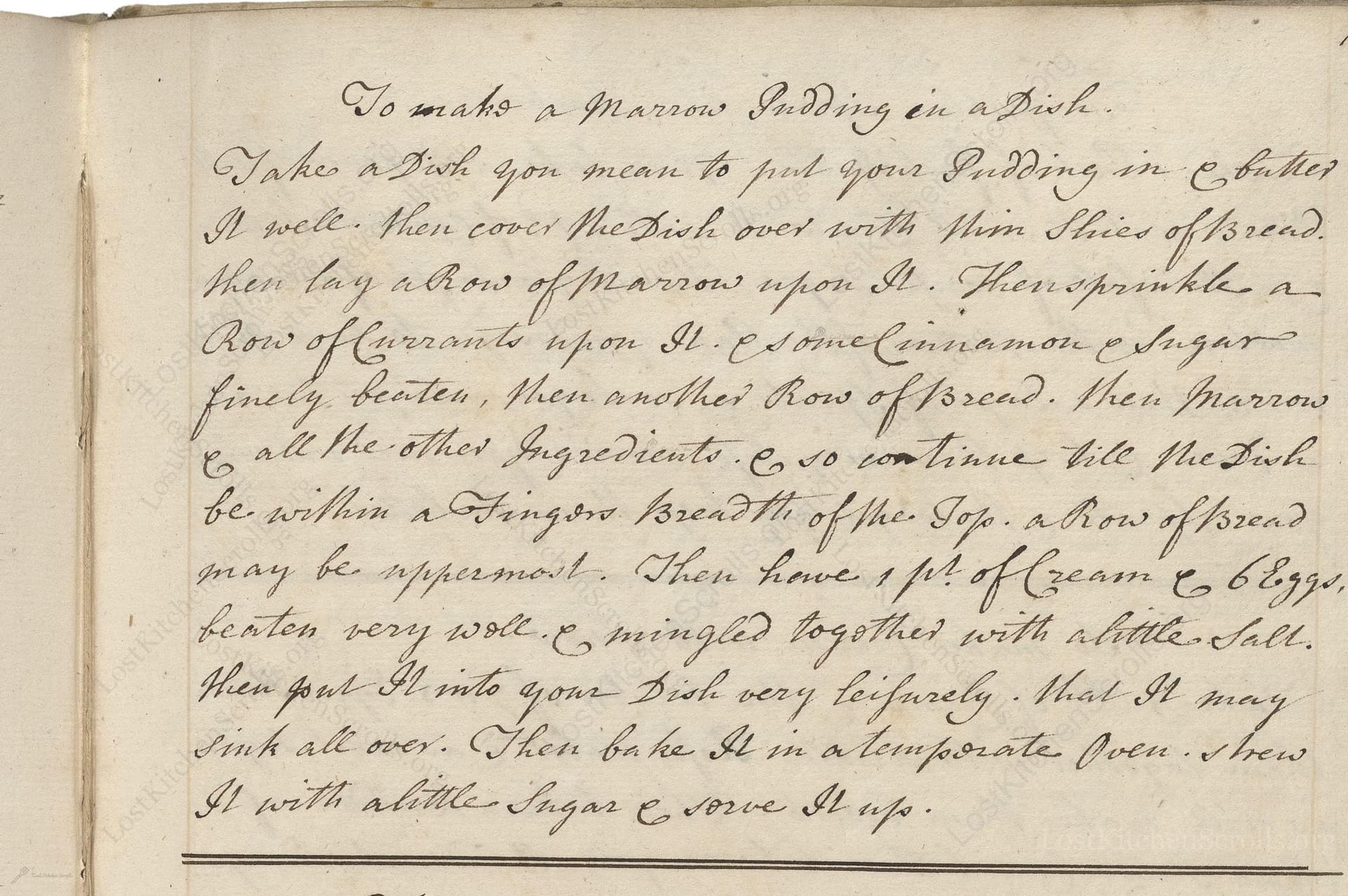To Make A Marrow Pudding In A Dish
From the treasured pages of Cookbook of 1725
Unknown Author

To Make A Marrow Pudding In A Dish
"Take a Dish you mean to put your Pudding in & butterr It well. Then cover the Dish over with thin slices of Bread. then lay a Row of Marrow upon It. Then sprinkle a Row of Currants upon It & some Cinnamon & Sugar finely beaten. Then another Row of Bread. Then Marrow & all the other Ingredients. & so continue till the Dish be within a Fingers Breadth of the Top. a Row of Bread may be uppermost. Then have 1 pt. of Cream & 6 Eggs, beaten very well, & mingled together with a little Salt. Then put It into your Dish very leisurely. that It may sink all over. Then bake It in a temporate Oven. Strew It with a little Sugar & serve It up."
Note on the Original Text
This recipe follows a layered, almost lasagna-style assembly, a hallmark of early bread puddings. The instructions presuppose a basic knowledge of household preparation and bakeware of the time. Quantities are approximate and measured visually or by the fill of the dish, which was common before standardized measuring. Spelling and capitalization are idiosyncratic—capitalizing many nouns and using ampersands. 'Marrow' refers specifically to the soft fat from beef bones, a prized ingredient in centuries past. 'Currants' means small dried Zante or Corinth grapes, not fresh currants. 'Row' simply means 'layer' in this context.

Title
Cookbook of 1725 (1725)
You can also click the book image above to peruse the original tome
Writer
Unknown
Era
1725
Publisher
Unknown
Background
A delightful window into 18th-century kitchens, this historical culinary volume whisks readers away with its charming recipes and savory secrets from a bygone era.
Kindly made available by
Folger Shakespeare Library
This recipe dates to around 1725, from an English household manuscript—a time when bread puddings were delicate, luxurious, and enriched with cream, eggs, and, notably, bone marrow. Marrow was a symbol of opulence, revered for its richness long before butter became widely accessible. Such puddings would have graced the tables of relatively prosperous households, often as a warm, comforting dessert or even as a special breakfast. Its presence in a manuscript hints at the domestic education of women and the transmission of culinary knowledge through hand-written collections.

In the early 18th century, this pudding would have been assembled with simple kitchen tools: a deep ceramic or earthenware baking dish, a sharp knife for slicing bread, and a spoon or small knife for scooping marrow from bones. Eggs would be beaten with a fork or whisk, and the mixture poured over the layers with a jug or ladle. Baking took place in a 'temperate' (moderate) oven, likely heated by wood or coal. Sugar was pounded and sifted by hand to eliminate lumps.
Prep Time
15 mins
Cook Time
45 mins
Servings
8
We've done our best to adapt this historical recipe for modern kitchens, but some details may still need refinement. We warmly welcome feedback from fellow cooks and culinary historians — your insights support the entire community!
Ingredients
- 8–10 slices (approx. 9 oz) good-quality white bread, thinly sliced
- 3.5 oz beef bone marrow (or 3.5 oz unsalted butter as substitute)
- 2.5 oz currants
- 1 teaspoon ground cinnamon
- 2 oz superfine (caster) sugar, plus extra for dusting
- 2 cups heavy (double) cream
- 6 large eggs
- Pinch of salt
- Butter, for greasing the dish
Instructions
- Begin by generously buttering a baking dish—an oval gratin dish or small casserole (about 2 quarts capacity) is ideal.
- Line the bottom and sides of the dish with thin slices of good-quality white bread (crusts removed, if you prefer).
- Next, layer spoonfuls of bone marrow (or softened unsalted butter, if marrow is unavailable) over the bread.
- Scatter a handful of currants, a dusting of ground cinnamon, and a sprinkle of superfine sugar over the marrow.
- Continue layering bread, marrow, currants, cinnamon, and sugar, repeating the sequence until the dish is nearly full, ending with a final layer of bread.
- In a separate bowl, whisk together 2 cups of heavy cream, 6 large eggs, and a pinch of salt until smooth.
- Slowly pour this custard mixture over the bread layers, allowing it to seep in evenly.
- Let the pudding rest a minute so the bread can soak up the liquid.
- Bake in a moderate oven (about 340°F) until golden and just set—roughly 40–50 minutes.
- Once out of the oven, dust the top with a little extra sugar, slice, and serve warm.
Estimated Calories
420 per serving
Cooking Estimates
Preparing the bread pudding takes about 15 minutes, including layering the ingredients and making the custard. Baking in the oven takes 45 minutes. One serving contains about 420 calories, and the recipe makes 8 servings.
As noted above, we have made our best effort to translate and adapt this historical recipe for modern kitchens, taking into account ingredients nowadays, cooking techniques, measurements, and so on. However, historical recipes often contain assumptions that require interpretation.
We'd love for anyone to help improve these adaptations. Community contributions are highly welcome. If you have suggestions, corrections, or cooking tips based on your experience with this recipe, please share them below.
Join the Discussion
Rate This Recipe

Den Bockfisch In Einer Fleisch Suppen Zu Kochen
This recipe hails from a German manuscript cookbook compiled in 1696, a time whe...

Die Grieß Nudlen Zumachen
This recipe comes from a rather mysterious manuscript cookbook, penned anonymous...

Ein Boudain
This recipe comes from an anonymous German-language manuscript cookbook from 169...

Ein Gesaltzen Citroni
This recipe, dating from 1696, comes from an extensive anonymous German cookbook...
Browse our complete collection of time-honored recipes



